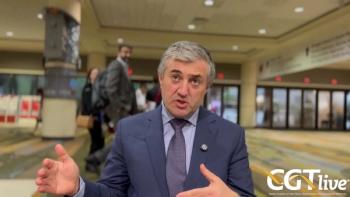
The Role of Mitoxantrone in Non-Hodgkin’s Lymphoma
Dr. Armitage presents a succinct and thorough review of the role of mitoxantrone (Novantrone) in patients with non-Hodgkin’s lymphoma (NHL). He begins by emphasizing the importance of accurate diagnosis as described in the World Health Organization classification which evolved from the Revised European American Lymphoma classification. Both of these present day classifications are based on the immunologic principles separating lymphomas into B- and T-cell disorders developed in the 1970s by Lennert, Lukes, and Collins.[1,2] His review addresses multiple issues in mitoxantrone therapy, including dose intensity, cardiotoxicity, combination therapy with nucleoside analogs in low-grade lymphomas, the impact of rituximab (Rituxan), therapy for acquired immunodeficiency syndrome (AIDS)-related lymphoma, and the role of high-dose mitoxantrone as part of a preparative regimen for autologous transplants.
Dr. Armitage presents a succinct andthorough review of the role of mitoxantrone (Novantrone) in patients withnon-Hodgkin’s lymphoma (NHL). He begins by emphasizing the importance ofaccurate diagnosis as described in the World Health Organization classificationwhich evolved from the Revised European American Lymphoma classification. Bothof these present day classifications are based on the immunologic principlesseparating lymphomas into B- and T-cell disorders developed in the 1970s byLennert, Lukes, and Collins.[1,2] His review addresses multiple issues inmitoxantrone therapy, including dose intensity, cardiotoxicity, combinationtherapy with nucleoside analogs in low-grade lymphomas, the impact of rituximab(Rituxan), therapy for acquired immunodeficiency syndrome (AIDS)-relatedlymphoma, and the role of high-dose mitoxantrone as part of a preparativeregimen for autologous transplants.
Dose intensity and dose equivalency have always been issues inthe treatment of NHL. In retrospect, the results of the Intergroup studyindicating that the new "intensive" regimensMACOP-B (methotrexate,leucovorin, doxorubicin [Adriamycin], cyclophosphamide [Cytoxan, Neosar],vincristine [Oncovin], prednisone, bleomycin [Blenoxane]), m-BACOD(methotrexate, bleomycin, doxorubicin, cyclophosphamide, vincristine,dexamethasone), and ProMACE/CytaBOM (prednisone, doxorubicin, cyclophosphamide,etoposide, cytarabine, vincristine, methotrexate)produced results equivalentto those achieved with CHOP (cyclophosphamide, doxorubicin HCl, vincristine,prednisone) should not be a surprise, because the doses of the most activeagents (cyclophosphamide and doxorubicin) were equivalent or higher in CHOPcompared to the newer regimens.[3]
Although CHOP has been shown to be superior to CNOP(cyclophosphamide, mitoxantrone [Novantrone], vincristine, prednisone) in arandomized trial in elderly patients,[4] Dr. Armitage argues that the study’sconclusion is based on the assumption that the doses of doxorubicin andmitoxantrone were equivalent. He maintains that the inferior results of CNOPcould be due to a lower dose of one drug (mitoxantrone) being compared to ahigher dose of another drug (doxorubicin)ie, the study did not compareequivalent doses. He indicates that even a small increase in the dose ofmitoxantrone could lead to similar response rates between CNOP and CHOP.
Progress in Therapy
Mitoxantrone is an effective agent in NHL, and Dr. Armitageaddresses its strengths. When compared to doxorubicin, mitoxantrone producesless alopecia, mucositis, nausea, vomiting, and cardiotoxicity. It has been beststudied as part of salvage regimens, particularly the MINE regimen (mesna[Mesnex], ifosfamide [Ifex], mitoxantrone, etoposide) and in combination withnucleoside analogs plus steroids for low-grade NHL. As Dr. Armitage points out,omitting the steroids for the latter regimen decreases the risk of opportunisticinfections without sacrificing efficacy.
Progress in the therapy of NHL has involved the development ofmonoclonal antibodies, better antiretroviral therapy for AIDS, and autologoustransplant as salvage. Combination chemotherapy with rituximab is becomingstandard therapy for many B-cell lymphomas, particularly diffuse large B-cellNHL, as evidenced by the results of the randomized European trial in elderlypatients, which favored CHOP plus rituximab over CHOP alone.[5] Highly activeantiretroviral therapy (HAART) has improved the prognosis of AIDS patients, andcombination chemotherapy can be administered to selected patients withAIDS-related lymphoma, often in conjunction with HAART and growth factorsupport.
The Parma trial established autologous transplant as standardtherapy for chemosensitive aggressive lymphomas[6]; however, there is littleconsensus about the best preparative regimens. Although mitoxantrone can be usedin the preparative therapy, the potential for cardiotoxicity exists due to thefact that most of these patients have already received anthracyclines.
Conclusions
Dr. Armitage reviews the strengths of mitoxantrone, but theagent is likely to remain a backup to anthracyclines unless randomized trialscan demonstrate its superiority. Better diagnostic and prognostic models willpredict which patients are more likely to be responsive to a specific therapy.Genomic profiling of large B-cell lymphoma can identify favorable andunfavorable prognostic groups that are not recognized by clinical factors.[7]Chemosensitivity assays may enable the identification of patients who would bebetter treated with an "inferior" drug earlier in the course of thedisease.[8] Dr. Armitage’s article provides a state-of-the-art review ofmitoxantrone in lymphoma, but the drug’s optimal use needs to be investigatedfurther.
References:
1. Lukes, RJ, Collins RD: Immunologic characterization of humanmalignant lymphomas. Cancer 34:1488-1503, 1974.
2. Lennert K, Stein H, Kaiserling E: Cytological and functionalcriteria for the classification of malignant lymphomata. Br J Cancer 31 (suppl):29-43,1975.
3. Fisher RI, Gaynor ER, Dahlberg S, et al: Comparison of astandard regimen (CHOP) with three intensive chemotherapy regimens for advancednon-Hodgkin’s lymphoma. N Engl J Med 328:1002-1006, 1993.
4. Sonneveld P, de Ridder M, van der Lelie H, et al: Comparisonof doxorubicin and mitoxantrone in the treatment of elderly patients withadvanced diffuse non-Hodgkin’s lymphoma using CHOP vs CNOP chemotherapy. JClin Oncol 13:2530-2539, 1995.
5. Coiffier B, Lepage E, Briere J, et al: CHOP chemotherapy plusrituximab compared with CHOP alone in elderly patients with diffuse large-B-celllymphoma. N Engl J Med 346:235-242, 2002.
6. Philip T, Guglielmi C, Hagenbeek A, et al: Autologous bonemarrow transplantation as compared with salvage chemotherapy in relapses ofchemotherapy-sensitive non-Hodgkin’s lymphoma. N Engl J Med 333:1540-1545,1995.
7. Shipp MA, Ross KN, Tamayo P, et al: Diffuse large B-celllymphoma outcome prediction by gene-expression profiling and supervised machinelearning. Nat Med 8:68-74, 2002.
8. Kravtsov VD, Greer JP, Whitlock JA, et al: Use of themicroculture kinetic assay of apoptosis to determine chemosensitivities ofleukemias. Blood 92:968-980, 1998.
Newsletter
Stay at the forefront of cutting-edge science with CGT—your direct line to expert insights, breakthrough data, and real-time coverage of the latest advancements in cell and gene therapy.
















































